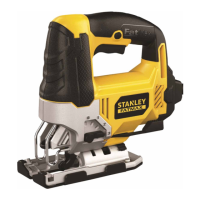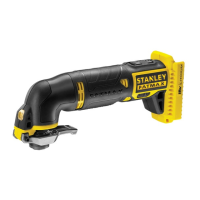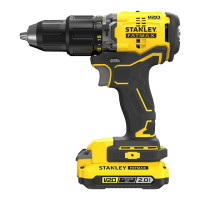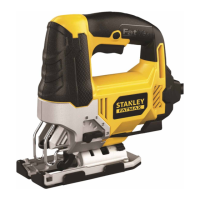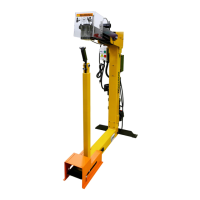English
5
(original instructions)
changing accessories, or storing power tools. Such
preventive safety measures reduce the risk of starting
the power tool accidentally.
d. Store idle power tools out of the reach of children
and do not allow persons unfamiliar with the power
tool or these instructions to operate the power
tool. Power tools are dangerous in the hands of
untrained users.
e. Maintain power tools and accessories. Check for
misalignment or binding of moving parts, breakage
of parts and any other condition that may affect
the power tools operation. If damaged, have the
power tool repaired before use. Many accidents are
caused by poorly maintained power tools.
f. Keep cutting tools sharp and clean. Properly
maintained cutting tools with sharp cutting edges are
less likely to bind and are easier to control.
g. Use the power tool, accessories and tool bits etc.
in accordance with these instructions, taking into
account the working conditions and the work to
be performed.
Use of the power tool for operations different from
those intended could result in a hazardous situation.
h. Keep handles and grasping surfaces dry, clean and
free from oil and grease. Slippery handles and
grasping surfaces do not allow for safe handling and
control of the tool in unexpected situations.
5. Service
a. Have your power tool serviced by a qualied repair
person using only identical replacement parts. This
will ensure that the safety of the power tool
is maintained.
b. Power to the tool should always be supplied via
residual current device with a rated residual
current of 30mA or less.
Additional safety warnings for oscillating tools
● Hold power tool by insulated gripping surfaces when
performing an operation where the cutting accessory
may contact hidden wiring. Cutting accessory
contacting a “live” wire may make exposed metal parts
of the power tool “live” and could give the operator an
electric shock
● Use clamps or another practical way to secure and
support the workpiece to a stable platform. Holding the
workpiece by hand or against your body leaves it unstable
and may lead to loss of control.
@
Warning! Contact with or inhalation of dusts arising
from sanding applications may endanger the health
of the operator and possible bystanders. Wear a dust
mask specically designed for protection against dust
and fumes and ensure that persons within or entering
the work area are also protected.
● Thoroughly remove all dust after sanding.
● Take special care when sanding paint which is possibly
lead based or when sanding some woods and metal
which may produce toxic dust:
t Do not let children or pregnant women enter the
work area.
t Do not eat, drink or smoke in the work area.
t Dispose of dust particles and any other debris safely.
● The intended use is described in this instruction manual.
The use of any accessory or attachment or performance
of any operation with this tool other than those
recommended in this instruction manual may present a
risk of personal injury and/or damage to property.
● The accessory will continue to move after releasing
the switch. Always switch the tool off and wait for the
accessory to come to a complete standstill before putting
the tool down.
● Keep hands away from cutting area. Never reach
underneath the work piece for any reason. Do not insert
ngers or thumb into the vicinity of the reciprocating blade
and blade clamp. Do not stabilize the saw by gripping
the shoe.
● Keep blades sharp. Dull or damaged blades may cause
the saw to swerve or stall under pressure. Always use the
appropriate type of saw blade for the workpiece material
and type of cut.
● When cutting pipe or conduit, make sure that they are free
from water, electrical wiring, etc.
● Do not touch the workpiece or the blade immediately after
operating the tool. They can become very hot.
● Be aware of hidden hazards, before cutting into walls,
oors or ceilings, check for the location of wiring
and pipes.
Safety of others
● This appliance is not intended for use by persons
(including children) with reduced physical, sensory or
mental capabilities, or lack of experience and knowledge,
unless they have been given supervision or instruction
concerning use of the appliance by a person responsible
for their safety.
● Children should be supervised to ensure that they do not
play with the appliance.
Residual risks.
Additional residual risks may arise when using the tool which
may not be included in the enclosed safety warnings. These
risks can arise from misuse, prolonged use etc.
Even with the application of the relevant safety regulations
and the implementation of safety devices, certain residual
risks can not be avoided. These include:
● Injuries caused by touching any rotating/moving parts.
● Injuries caused when changing any parts, blades
or accessories.
● Injuries caused by prolonged use of a tool. When
using any tool for prolonged periods ensure you take
regular breaks.
● Impairment of hearing.
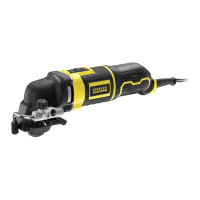
